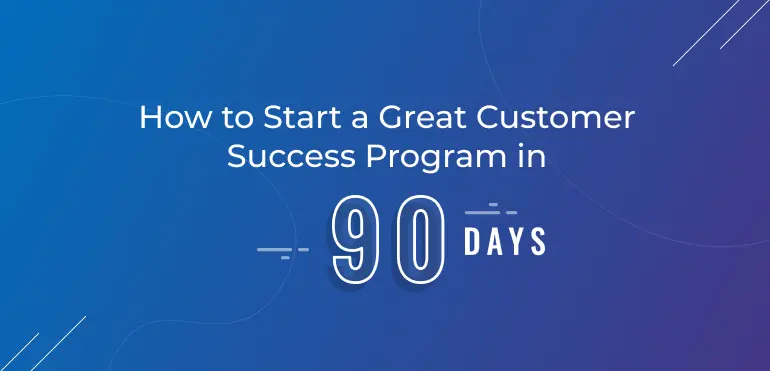As a SaaS owner, nothing is harder than competing with a gazillion other tools that seem to be as good as your own — at least on the outside. The software might not be top-notch, but the marketing pages are darn good. And that is often enough to convert leads into trial users.
How can you compete with that? The solution is to let your existing customers promote your business.
Customer testimonials are a very strong social signal, one that can turn warm leads into hot ones who are ready to hit the subscribe button.
The only challenge is that you need to create testimonials that are convincing, honest, and relatable. And that’s what I will talk about in this blog post.
What are customer testimonials?
A testimonial is a recommendation from a happy customer who iterates the quality of your SaaS product. Customer testimonials can be created in a variety of different formats, with the most common being the written one.

A written customer testimonial is usually nicely presented on landing pages along with the customer’s image and company logo.
Benefits of customer testimonials
Social proof — you’ve heard the term, I’m sure. People love the opinion of other people. But not anyone, someone who is like you, the owner of a SaaS tool researching customer success software.
There are a few things you don’t want to do:
- Waste time trialing software you’re not interested in.
- Pay for a trial only to find out that the software isn’t a good fit.
- Hop on hour long sales calls that don’t provide the right answers.
Instead, you’d love to see the opinion of people similar to you who are successfully using the tool already — and how it improved their SaaS.
This is where the testimonials come in, they push someone who is either…
- not sure if the tool is the right fit, or
- who needs a bit more convincing to purchase it.
Does it work? According to a TrustPilot study, 66% of customers mentioned that they are more likely to purchase a product if social proof is present. The important thing to note is that testimonials are very effective when customers compare different products, even more-so than reviews.
When you say it, it’s marketing. When your customers say it, it’s evidence. Video testimonials in particular are an effective way to build trust with buyers. Try and figure out what your buyers biggest “objections” are during your sales process, and address those questions from the voice of the customer.
—Sam Shepler, CEO at Testimonial Hero
Speaking of reviews, are testimonials the same as customer reviews?
The difference between testimonials and customer reviews
One might think that reviews are the same as testimonials — spoiler alert, they are not.
There are two key differences between reviews and testimonials:
- Testimonials are usually sought out by a SaaS in order to be used in promotional materials.
- Testimonials are always positive because they are supposed to put the SaaS in a good light.
A review is an unbiased opinion, that can be positive or negative in nature. It often critiques a SaaS based on the customer’s past experience. Many use independent websites such as TrustPilot, Capterra, or G2 to leave their review without being incentivized to do so.
With that said, you can turn a positive review into a testimonial — with the customer’s approval of course.
Here’s an example from Custify’s Capterra page that could be turned into a testimonial:

Do both of them have any influence on SEO, though? They actually do, and in two ways: social proof increases the time spent on your landing pages, which in return is a positive signal for search engines. Make sure to mix and match between reviews and testimonials. For instance, focus on independent reviews and star ratings on your homepage, but use testimonials on the marketing pages.
Another SEO impact is that the reviews could contain important keywords, such as “best customer success software for SaaS.” Make sure that you select Testimonials from reviews based on your main keywords.
3 Examples of SaaS testimonials that simply work
Prezly
PR Software Prezly didn’t use social proof on their signup page, so they decided to implement it.
Many SaaS platforms have very basic sign-up pages that try to improve conversion by being simplistic. They often lack any sort of social proof, though.
Bonjoro
Video engagement platform Bonjoro went all out when it comes to testimonials and reviews. Their header consists of four sliding testimonials, each with a different social proof message.

Every message iterates how Bonjoro has helped that specific customer, which is a great way of showcasing your SaaS.
Thryv
The small business & CRM software Thryv created a video testimonial featuring one of its clients.
The video focuses on what that customer values the most, namely using the iOS app, making use of scheduling and the invoicing feature.

Plus, they’ve repurposed the video testimonial for social media by using a quote from it.
How to collect customer testimonials
When you think about customer retention, one thing you might not pay too much attention to is asking for feedback at the right time. But you should, after all, timing is everything when you need to ask a customer for a thankless task.
Here are some good times to ask for a testimonial:
- after a positive interaction with your support team
- after reaching a milestone inside their app
- after they’ve left a positive review on a third party website
Once you’ve nailed the timing, you can start with the testimonial collection. But first, what makes them so great for social proofing your SaaS?
The cool thing about testimonials is that you can easily re-use them. If it’s a written one, put it on your landing pages, use it in social media posts, and integrate them into email campaigns. You can also embed Instagram posts featuring customer testimonials directly on your website to showcase authentic feedback and social proof.
Video testimonials are even better because you can create snippets from them and re-use them in different channels.
Now, let’s look at different ways you can collect customer testimonials, and their pros and cons.
Contact form
Contact forms are a simple way to ask for customer feedback, and if it’s positive, turn it into quote testimonials — with the client’s approval of course.

In order to minimize the risk of customers not leaving feedback, ask very specific questions, and keep them to a minimum. Make it also easy to submit the form without having to enter too much information. Ideally, you should pre-fill the form with the customer’s name and email address.
Pros:
- many free solutions available
- potential for automation
Cons:
- manual work
Testimonial collection via email is another easy way to get feedback from your customers.

There are two ways you can do this, manually or automated:
- Manual email testimonial collection: While this requires more effort, you can target customers better to ensure that you ask for a testimonial at the perfect moment. This could be after a positive support interaction or after having a check-in call with them.
- Automated email testimonial collection: Automations reduce manual tasks, but they also need to be meticulously set up to ensure they trigger at the right moment. Luckily, Custify can help with segmentation and custom events.
Pros:
- free
- highly targeted
Cons:
- not easy to automate
- manual work
SMS & WhatsApp
SMS is still king in some countries, such as the United States of America, with the SMS marketing market growing 20% between 2019 and 2025. In other regions, WhatsApp is much more prevalent, especially in Europe and Asia. 58% of users prefer messaging over filling out a form on a website, making WhatsApp a great tool for testimonial collection.

The biggest advantage of WhatsApp is that it makes it easier compared to SMS to be used for business purposes. All you have to do is to create a business account, giving you access to its powerful API. For SMS, you need to use an external provider such as Twilio to build your automations.
Of course, you could also just manually text your customers, and ask for a testimonial.
Pros:
- high deliverability
- preferred contact method for users
Cons:
- involves cost for WhatsApp/third part provider
- not easy to automate
Social media
Many users express their love for a SaaS on social media. If they are your customer, why not reach out and ask them if you can turn their tweet into a testimonial?

The best thing is that it’s effortless for them because they’ve already written it. All you have to do is to create the testimonial and put it on your website, or use it in other marketing campaigns.
Pros:
- can be highly targeted
- testimonial often ready-to-use
Cons:
- users might not be responsive to requests
Testimonial collection apps
As testimonials are more and more used in SaaS companies, apps have made their way onto the market that target this demand. They allow you to easily ask clients for testimonials, create embeds, and even support analytics.

Of course, these apps are rarely free, or they are branded unless you upgrade to a paid version. But you get a lot of features for the price that the other collection methods cannot offer.
Pros:
- user-friendly
- easy to build ready-to-use testimonials
- testimonial hosting & analytics included
Cons:
- free versions use app branding
- reliance on a third party
Testimonial collection services
An alternative to testimonial collection apps are service providers who built a service around this demand. Depending on the service, they…
- help companies with remote testimonials,
- turn them into written case studies and social posts, or
- provide instructions on how to self-capture testimonials.

The biggest advantage is that the quality of the testimonials is much higher because there’s a certain quality standard associated with each service.
Pros:
- multiple testimonial versions available
- more professional and credible results
Cons:
- pricey
- not globally available
How to use customer testimonials as a SaaS
Now that you know how to collect the testimonials, let’s see how and where you can make use of them.
To understand better where they are effective, check out the below table from the aforementioned TrustPilot study.

As you can see, testimonials are most effective while comparing retailers. In SaaS, it makes sense to use testimonials therefore on your alternatives pages.

The best testimonial would be from a client who switched from a competitor to your SaaS solution. Create alternatives pages in the format “your SaaS tool vs competitor A”, find a client that switched from each competitor — and use the testimonial on the alternatives page.
What could be more convincing than that?
Other than alternatives pages, there are more ways you can use testimonials. Let’s look at them below.
On social media
Social media can be a great channel for testimonials, especially when you have very happy customers like this one:

The conversation was kick-started by the SaaS founder of SPP, Chris Willow, leading to someone else asking what the deciding factor for the switch was.
This is a prime example of why it’s important to keep the conversation active, although it has to be relevant and genuine.
On landing pages
Let’s look at what a good testimonial for a landing page looks like based on Custify’s automation page.

Why does this work so well? It’s relevant, meaning the customer quoted is in charge of automations at his company. And he mentioned that their team can handle three times more clients.
In-app
In-app testimonials can be used in a variety of ways, but one of the most effective ones is during the checkout process like seen here in Loganix’ client portal:

It’s worth pointing out that they used a testimonial from a well-known person (Brian Dean), which people familiar with the industry would know.
In email marketing
Email marketing is powerful in itself, but even more-so when you integrate customer testimonials in a genuine way such as in this example from Usersnap:
The key ingredient is that they used Canva as an example, a tool that everyone has heard of. This makes it easy for potential customers to relate to the success story.
Frequently asked questions
How do you make testimonials look good?
Design the testimonial box in a way that it stands out from the rest of the content. If it’s a video testimonial, ensure that the play button is prominent and clickable. When it comes to authenticity, it pays off to create quote testimonials from reviews, and link to the original source.
What is the format of a testimonial?
A testimonial typically includes the name of the person, their title, and a statement. For more credibility, testimonials usually also include the person’s photo and the company logo.
How can I deal with negative testimonial feedback?
Use the negative feedback to improve your product, reach out to the customer with a proposed solution, and turn it into a positive testimonial that you can use on your website.
How can I measure the impact of testimonials on sales?
Use A/B testing in order to measure the impact of a testimonial on sales. First, compare a page without a testimonial with one that uses it. Afterwards, A/B test different testimonial formats and pick the winning format.
What incentives can be offered to customers that could motivate them to leave a testimonial?
You can offer discounts on recurring subscriptions or access to extra features in order to motivate customers to leave a testimonial. However, ensure that the testimonial remains unbiased and genuine.
Where is the ideal placement for a testimonial within these platforms for maximum impact?
On social media and in emails, integrate testimonials naturally within the content. On landing pages, place testimonials close to key conversion points like “Buy Now” or “Sign Up” buttons.
Implement customer testimonials in your marketing strategy
Customer testimonials are an essential part of any SaaS marketing strategy. They offer authentic social proof that can boost conversions and sales. It’s important to not only understand how to acquire compelling testimonials, but also make use of them across your marketing platforms: landing pages, social media, and emails.
Keep in mind that an effective testimonial should be relatable, showcase easy-to-understand benefits, and be positioned where potential customers are likely to see them during decision-making moments. When used effectively, testimonials can truly help your SaaS stand out among competitors and connect better with your target audience.






